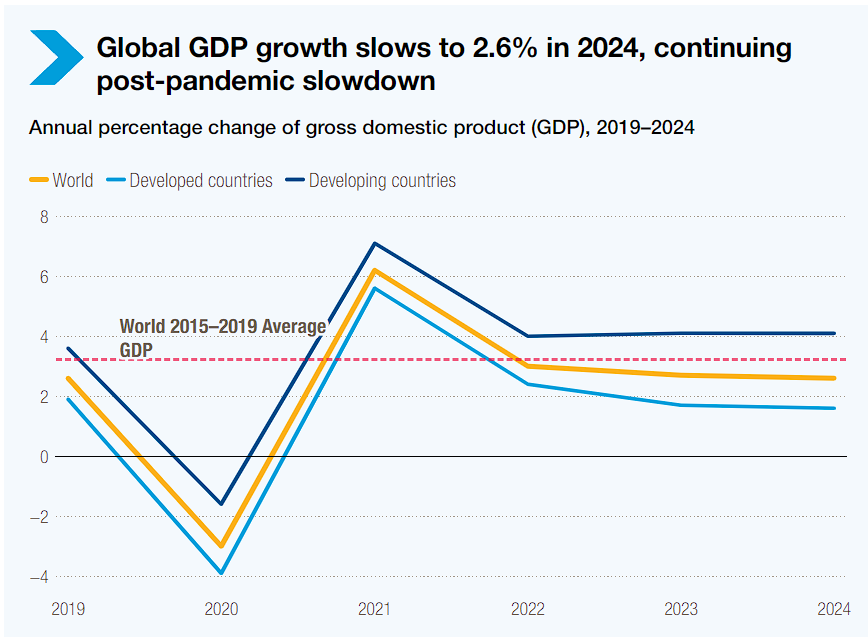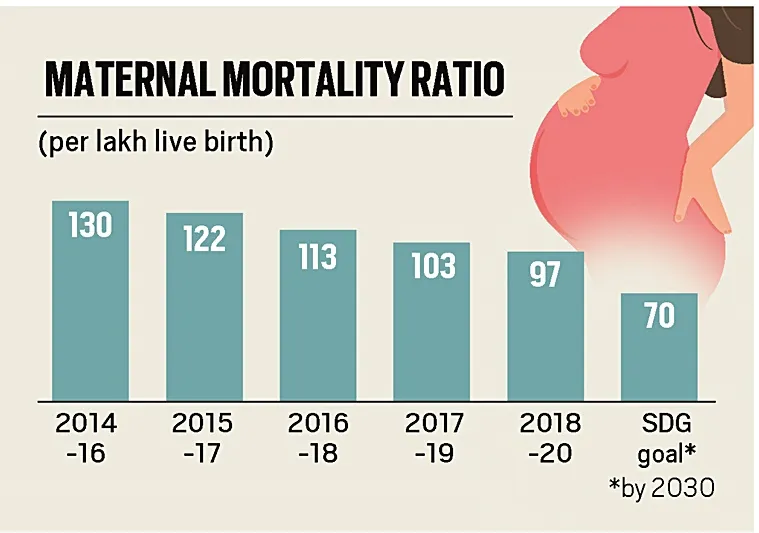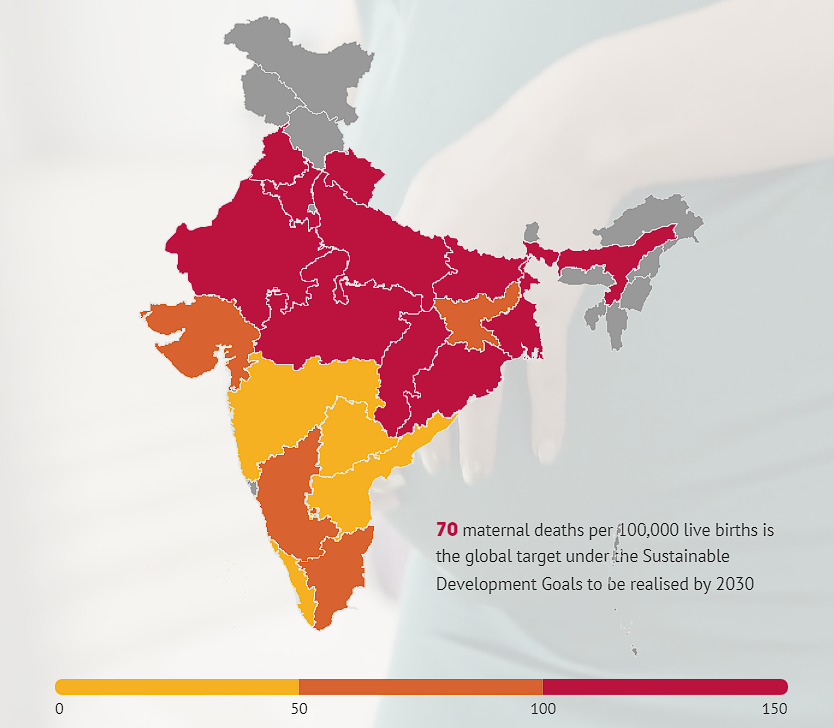Table of Contents
India’s Economic Growth
Context: As per the recent UN Trade and Development (UNCTAD) Trade and Development Report Update, India grew by 6.7% in 2023 and is expected to grow by 6.5% in 2024.
Overview of India’s Economic Performance
- Growth Rate: India recorded a growth rate of 6.7% in 2023 and is projected to expand by 6.5% in 2024, maintaining its position as the fastest-growing major economy globally.
Drivers of Growth
- Strong public investment and a vibrant services sector fueled India’s economic expansion in 2023.
- Robust local demand for consumer services and strong external demand for the country’s business services exports contributed to this growth.
- Manufacturing Base: Multinationals are increasingly focusing on India as a manufacturing base to diversify their supply chains, a trend influenced by developments in China.
- Supply Chain Diversification: The report highlights the growing trend of multinationals extending their manufacturing processes into India, which is seen as an alternative manufacturing base amidst developed economies’ supply chain diversification strategies.
Monetary Policy and Fiscal Outlook
- Reserve Bank of India: The report predicts that the Reserve Bank of India will maintain interest rates at a constant level in the near term.
- Government Spending: While public consumption spending is expected to remain restrained, strong public investment expenditures are anticipated to offset this restraint.
Economic Landscape in Southern Asian Countries
- Subdued Growth: Economic growth in Southern Asian countries like Bangladesh, Pakistan, and Sri Lanka remains subdued. These countries are currently under IMF programs, which entail tight monetary policies and fiscal austerity measures, affecting low-income households the most.
Global Economic Outlook

- Economic Challenges: The report notes that despite some economies, including China and India, avoiding financial troubles, the world economy grew by a modest 2.7%, highlighting challenges such as trade disruptions, climate change, low growth, under-investment, and inequalities.
- China’s Economic Performance: China’s economy, projected to grow by 4.9% in 2024, faces challenges such as external uncertainties, a troubled housing market, an under-performing labor market, and subdued consumption.
| About UNCTAD (United Nations Conference on Trade and Development) |
|
|
Glacial Lake Outburst Floods
Context: The Sikkim Government’s report has highlighted a link between unusually heavy rainfall and the Glacial Lake Outburst Flood (GLOF) event at South Lhonak Lake last year.
Glacial Lake Outburst Flood (GLOF)
- Definition: A GLOF is a flood that occurs when water dammed by a Glacial Moraine is released suddenly.
Glacial Lakes
- Glacial lakes, exemplified by South Lhonak Lake, are expansive bodies of water situated in front of, atop, or beneath a melting glacier.
- As they expand, they pose increasing hazards due to containment by precarious ice or sediment formations.
- In case the boundary around them breaks, huge amounts of water rush down the side of the mountains, which could cause flooding in the downstream areas. This is called glacial lake outburst floods (GLOF).
Causes of GLOF
- Natural Triggers: GLOFs can be instigated by various factors, including seismic activity such as earthquakes, torrential rainfall, and ice avalanches.
- Geographical Context: Given their prevalence in rugged, mountainous terrains, occurrences like landslides or ice avalanches may directly impact these lakes.
- Historical Examples: In 2013, Uttarakhand’s Kedarnath witnessed flash floods alongside a GLOF from the Chorabari Tal glacial lake, resulting in significant loss of life.
- Other Key examples of GOLF-related disasters include:
- 1926 Jammu and Kashmir deluge
- 1981 Kinnaur valley floods in Himachal Pradesh
Sikkim GLOF event
Due to inaccessible terrain, it is difficult to determine the real cause. A combination of excess rainfall + series of earthquakes in Nepal may have caused the Sikkim GLOF event.
- The Sikkim GLOF event led to the destruction of the Chungthang dam (located on Teesta River).
- Increased frequency of GLOF events is being seen due to climate change
Maternal Mortality Rate
Context: The Indian Council of Medical Research (ICMR) is funding a study to analyse the number of maternal deaths because of heart diseases and develop a treatment protocol to prevent future mortality.
About Maternal Mortality Ratio
- It is defined as the number of maternal deaths during a given time period per 100,000 live births during the same time period.
- It depicts the risk of maternal death relative to the number of live births and essentially captures the risk of death in a single pregnancy or a single live birth.
Causes of Maternal Mortality
- According to a 2022 study , the leading causes of maternal deaths were:
- Haemorrhage or uncontrolled bleeding (47 per cent),
- Pregnancy-related infection (12 per cent),
- Hypertensive disorders of pregnancy (7 per cent)
Trends in India
- Over the last two decades, India’s MMR has gone down by 70 per cent, according to a 2022 study.
- Government data pegs it at 97 deaths per lakh live births between 2018 and 2020.

About the Study
- The study will be held across 50 centres and AIIMS.
- It will not only identify the 10 most common heart diseases in pregnant women but also develop their treatment protocol that can be accessed in remote rural pockets.
- It will include sites across India — from Kashmir to Tamil Nadu, and from Assam to Rajasthan to be representative of the Indian population.
States that have achieved SDG target

| State | |
| Kerala | 19 |
| Maharashtra | 33 |
| Telangana | 43 |
| Andhra Pradesh | 45 |
| Tamil Nadu | 54 |
| Jharkhand | 56 |
| Gujarat | 57 |
| Karnataka | 69 |
Examples, Data and Case Studies For Value Addition
Estimated cost of damage caused by climate change (GS3) : German government-backed research estimates that by 2050, the damage to farming, infrastructure, productivity, and health from climate change will cost an estimated $38 trillion per year.


 Utkal Divas 2025: Odisha Foundation Day ...
Utkal Divas 2025: Odisha Foundation Day ...
 List of Military Exercises of India 2024...
List of Military Exercises of India 2024...
 GPS Spoofing and Its Impact in India: A ...
GPS Spoofing and Its Impact in India: A ...





















